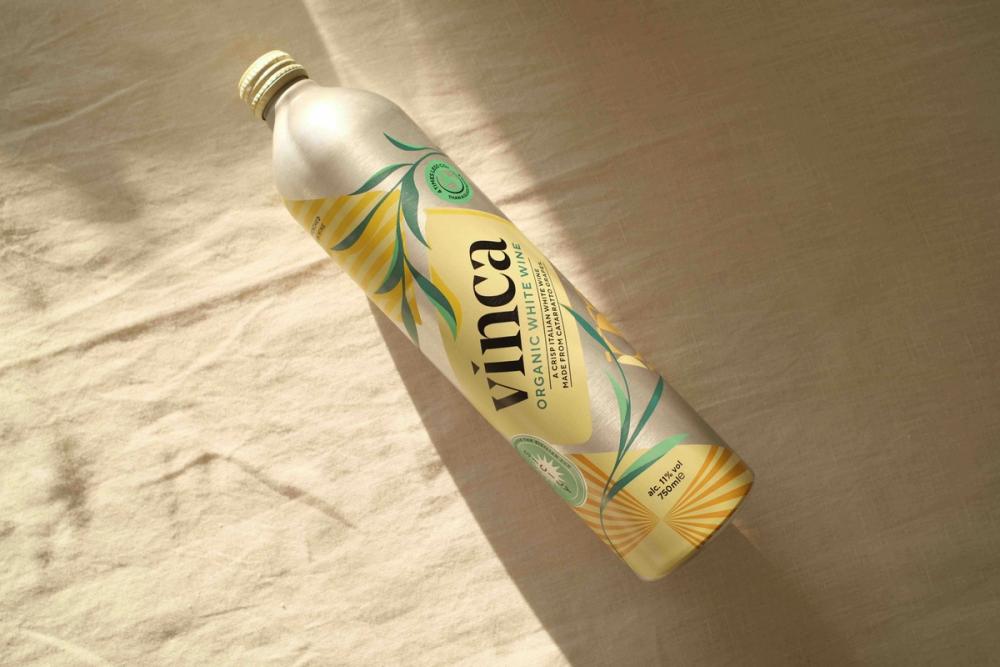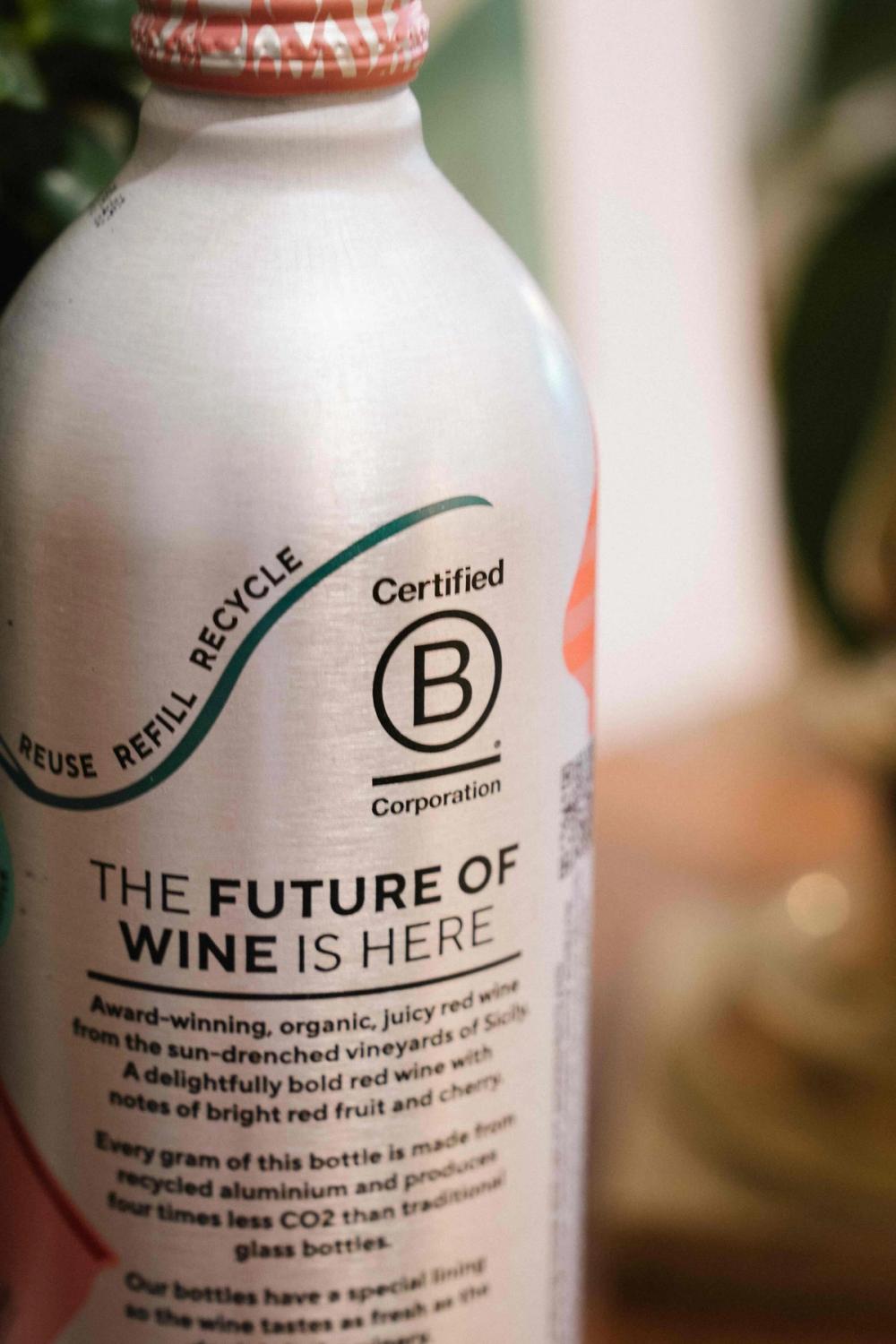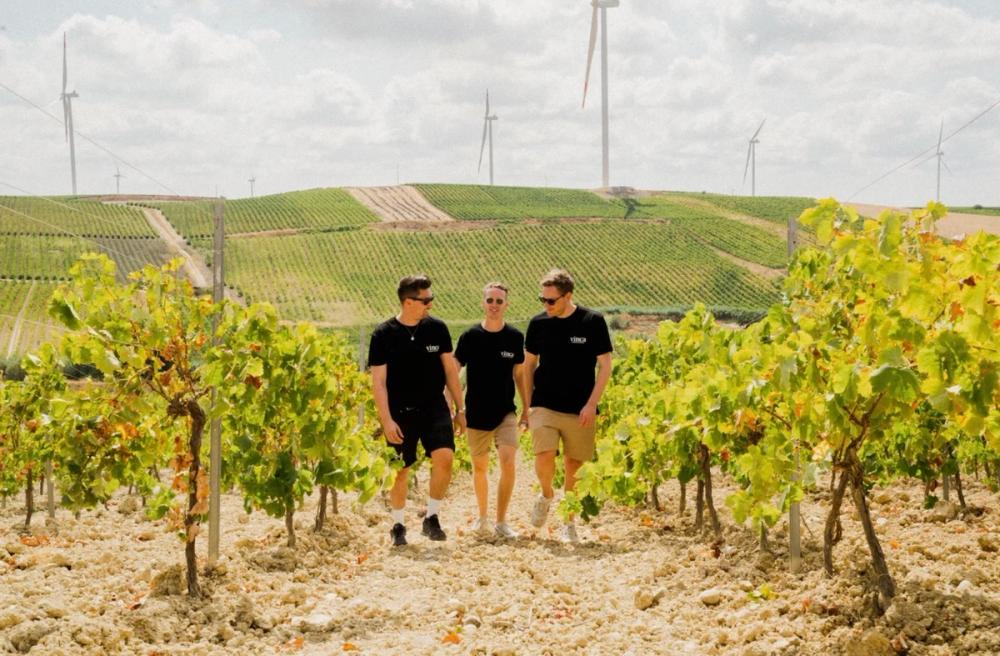You are introducing new aluminium bottles to your range – tell us about why you are doing this?
We launched Vinca three years ago to put exceptional wine into cans. The format works brilliantly across so many occasions: flights, festivals, stadiums, and when you just want one glass. But time and again, we were being asked, “When are you going to do a bottle?”
Sometimes people just want to take a bottle to a BBQ or dinner with friends, and they want something that's better for the planet than glass. We saw a clear opportunity to give them that. A full-size bottle that’s genuinely sustainable, lightweight, unbreakable, and still delivers amazing wine.

The breakthrough new aluminium can from Vinca that is being launched in Tesco
It also helps us meet growing demand from both customers and forward-thinking businesses who are building sustainability into everything they do. Many large restaurant groups, for example, are working toward net zero targets and looking for packaging that reflects those values without compromising on quality or shelf appeal. The aluminium bottle fits that brief perfectly. It's a natural step forward for us and a brilliant complement to our can format.
Why did you want to work with aluminium out of all of the alternative packaging options there now are?
We did look at a range of new eco-packaging options, including the paper bottle, which is getting a lot of attention. But the reality is, it's made from four different materials, which makes it hard to recycle, especially at scale. You can't assume that customers at festivals or large events will separate layers into different bins. We wanted a simpler, closed-loop solution made from just one material.
So we developed our own aluminium bottle. It's fully recyclable, endlessly reusable, and our wine-grade lining protects the wine brilliantly.
What sustainability credentials do they have over other packaging formats?
Aluminium is one of the most recycled materials globally. Around 75% of all aluminium ever made is still in use. It’s lighter than glass, reducing transport emissions, and unlike glass and plastic, it doesn’t degrade in quality when recycled. Our bottles are made entirely from PCR (post-consumer recycled) aluminium, so we’re not just talking about recyclability. We’re actually using recycled material from the start.
There are five ways these aluminium bottles are more sustainable:

1: They are five times less carbon-intensive to produce than glass.
2: Vinca’s aluminium wine bottle slashes carbon emissions by nearly 50% compared to glass.
3. It has a 47% lower total carbon footprint than glass — and it’s infinitely recyclable.
4: Glass bottles generate almost double the carbon footprint of the Vinca aluminium bottle — before they even hit the shelf.
5: Switching from glass to Vinca aluminium bottles cuts 1.06 kg of CO₂e per bottle — that’s the equivalent of charging your phone 135 times.
Where do you source your aluminium from?
We use 100% post-consumer recycled (PCR) aluminium, which means every gram we use has already had a life before, whether as a can, tray, or another product. It’s important to us that we’re not just using recyclable materials, but actually using recycled ones. It closes the loop and keeps valuable resources in use.
You are working with Tesco to introduce them to the market – how did that relationship come about and what are they looking for from the bottles?
Tesco has been a brilliant partner for us. We already stock some of our cans with them, so this was a natural next step in the relationship. When we first showed them the aluminium bottle concept, they immediately saw the potential.
Tesco is focused on giving customers more choice and offering new formats that reflect how people actually live and drink today. The aluminium bottle gives them something genuinely different. It's portable, good-looking, and sustainable.
It has already done great work to reduce the average weight of their wine bottles to 410g. Our bottle weighs just 68g empty, so it’s a big step in the right direction and supports the progress it is already making.
We have two wines in the aluminium bottles going into 300 of its stores: Organic Catarratto (750ml; 11% ABV); and Organic Syrah & Nero D’avola (750ml; 12% ABV).
The bottles are also easier to display on shelf?
Definitely. They’re unbreakable, eye-catching, and they really stand out. I went into my local Tesco on launch day and they looked like nothing else on the shelf. That kind of standout matters both for customers looking for something new and for retailers who want to offer something a bit different in the wine aisle.
The space-saving design allows retailers to merchandise three Vinca bottles in the same space as two glass bottles.
What is the process of filling the bottles – how different is it from the cans you usually have?

Vinca's co-founder Jack Green says the aluminium bottles have the same quality organic wine - sourced from Sicily - than it has in its original canned format
It’s not wildly different, but the bottling line is custom-built for this size and shape. Just like with our cans, we treat the wine with a lot of care to protect its character. To get a bit geeky with it, we monitor free SO₂ and oxygen levels closely, running tests in the onsite lab before, during, and after filling.
The key to making the wine taste perfect in this format is keeping both sulphur and oxygen levels low. That’s been our approach from day one, and it’s what ensures the wine tastes exactly as it should, wherever you drink it.
You are working with Buckingham Schenk – what are you doing together and why did you want to work with them?
We’ve partnered with Buckingham Schenk for our off-trade distribution. They totally get what we’re about and were immediately impressed with the quality of our wines. They’ve also got a great track record when it comes to launching new formats in the right way, without losing focus on what really matters. Quality and taste. We clicked with them straight away and it’s been a really solid partnership.
With Trump’s tariffs do you see an issue with the cost of aluminium and what steps can you take to safeguard your supply and manage the costs?
We keep a close eye on global markets and have strong relationships with our suppliers to help manage any volatility. So far, we’ve been able to maintain a stable cost base and our focus is always on building long-term partnerships, not chasing short-term wins.
That said, it's been interesting timing with the new Extended Producer Responsibility (EPR) regulations. For the first time, sustainable packaging solutions are being properly recognised, and aluminium beverage packaging, including our bottles and cans, is exempt.
Of course, producing a bottle from 100% PCR aluminium costs more than glass, but it’s encouraging to see that forward-thinking businesses like ours aren’t being penalised with extra taxes while we’re trying to push sustainable wine innovation to the forefront.
You are sourcing your wine from Sicily - any plans to extend the range into other regions, or countries?

Vinca's founders have sourced all their organic wines from Sicily
Sicily will always be home for us. It’s where the story started and the winemaking there is incredible. The quality, the people, the energy. It just fits who we are. But we’re definitely open to exploring other regions if it feels right and stays true to our values. The wine has to be delicious and the people we work with have to care as much as we do.
Watch this space.
Any other steps you are taking around sustainability?
We’re always looking at every part of our supply chain. Transport, materials, energy use. We make smart decisions that reduce impact without making empty claims. No greenwashing, no gimmicks, just honest work to do things better.
Recently, we worked with Zevero on a full carbon accounting project to look at the lifecycle of our aluminium bottles from cradle to grave. We already knew that producing the empty bottle using PCR aluminium generates four times less carbon than a glass bottle, but we wanted to go further. What happens when it's filled, transported, bought, chilled at home, and finally recycled?
Zevero analysed every stage, even down to the energy used to power a customer’s fridge, and found that our aluminium bottles slash carbon emissions by 47% across their full lifecycle. That’s a reduction we’re incredibly proud of and it reinforces why we believe so strongly in this format. Imagine if every wine bottle on the shelf was made from Aluminium?
Anything else to say?
Just that we’re excited to bring something new and genuinely useful to the wine world. At the end of the day, we’re here to make top-quality wine that fits into modern life and maybe challenge a few assumptions along the way.
The wine industry can move slowly at times, and we’re here to shake things up. Younger drinkers are moving away from wine. In fact, recent studies show that Gen Z are drinking 20% less alcohol overall than Millennials did at the same age. Wine can feel stuffy, overly complicated, and stuck in the past.
We want to make it simpler, more sustainable, and more inclusive without compromising on quality. We’re here to get more people drinking exceptional organic wine in a way that works for how they actually live today.
* You can find out more about Vinca and its range and new aluminium bottles at its website here.
































